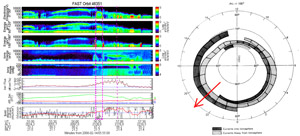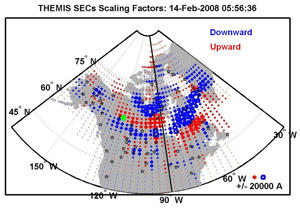
2012 THEMIS SCIENCE NUGGETS
In-situ observation of the "pre-existing auroral arc" by THEMIS All Sky Imagers and the FAST spacecraft
by Feifei Jiang, UCLA ESS/IGPP
Introduction
Active auroras are the most spectacular natural-light display in the polar skies. They are caused by the collision of energetic charged particles with atoms in the high altitude atmosphere. The charged particles come from the Earth’s magnetosphere and they are directed by the Earth’s magnetic field into the atmosphere. Although very dynamic, auroral emissions commonly evolve in a predictable manner. In optical cameras, active auroras always involve brightening and expansion of a discrete auroral arc (auroral substorm). The arc that brightens is usually the most equatorward of several auroral arcs that remain quiescent for ~30 minutes or more before the activity commences. However, the magnetospheric source of the energetic electrons that excite the preexisting auroral arc is not well understood. The magnetospheric counterpart of the arc remains enigmatic largely because of the uncertainty of mapping along the magnetic field lines from the ionosphere to the magnetotail. In this study, we combined ground optical observations with in-situ measurements from low-altitude spacecraft flybys to provide insight into the pre-existing arc’s source in the magnetosphere.
| Figure 1. Snapshots of an auroral substorm on Feb. 14 2008 from THEMIS ASI. The UTs of snapshots (a) to (e) are indicated at the top of the images. A substorm onset occurred at 0604:24 UT. The trajectory and footprint of FAST are indicated by a yellow dotted line and a yellow cross. In Figures 1b to 1d, the preexisting arc is identified by red asterisks. |
Results
Figures 1a to 1e are consecutive images of an auroral substorm acquired by five THEMIS ground imagers between 0554:00 UT and 0607:00 UT on Feb. 14 2008. The bright spot imaged at each station (marked by the yellow ellipse in the circles at the northeast) is moonlight. FAST flew through the northern auroral zone during this conjunction. Its trajectory as mapped to the northern hemisphere is indicated by the yellow dashed line, and its footprints are indicated by yellow crosses at the times (UT) corresponding to Figures 1a to 1c. Prior to the auroral breakup, several discrete arcs were present in the field of view of the imagers. The most equatorward one is a thin, faint arc that becomes visible (barely) in the image acquired as FAST crossed it at 0556:36 UT (Figure 1b, in which the red crosses have been placed at several positions along the faint arc). The arc brightened at 0604:24 UT (Figure 1d), and thereafter expanded poleward (Figure 1e).
| Figure 2. FAST data including the arc crossing on Feb. 14 2008. Panels from top to bottom are: energy flux spectrum versus energy (ranging from 4 eV to 30 keV) for electrons with a pitch angle range from 0° to 30°; energy flux spectrum versus energy for electrons with a pitch angle range from 60° to 120°; energy flux spectrum versus energy for electrons with a pitch angle range from 150° to 180°; omni-directional ions energy flux spectrum; ions energy flux spectrum versus pitch angle for all energies; integrated field-aligned fluxes of ions over an energy range from 1 keV to 25 keV (black) and the average fluxes (red); components of the magnetic field perturbations in the field-aligned coordinate system: the blue trace is the perturbed magnetic field component along the magnetic field (away from the earth for the southern hemisphere), the green trace is the east-west component of the perturbed magnetic field with positive direction to the east, and the red trace is the poleward component, with positive direction to the south; FAC density derived from magnetic field perturbations (black) and averaged current density (red). The preexisting arc corresponds to the magenta dashed rectangle. The inner edge of 1 keV electrons is indicated by the dashed line. |
Figure 2a shows the FAST data for this event. Panels from top to bottom are described in the figure caption. Figure 2b illustrates the trajectory of FAST relative to the large-scale field-aligned current (FAC) distribution. The dashed magenta rectangle in Figure 2a identifies the interval during which FAST observed precipitating electrons associated with the crossing of the preexisting arc shown in Figure 1b at 0556:36 UT. The flux of electrons with energy around a few hundred eV is greatly enhanced near 0° in pitch angle compared with that near 180° in pitch angle (1st and 3rd panel). This is indicative of a field-aligned potential drop of a few hundred eV that accelerates the electrons into the northern hemisphere. The dashed line at 05:57 marks the inner boundary of the 1 keV electron plasma sheet, where a sharp drop occurred in the trapped electron fluxes. The arc is located 1° poleward of the inner edge of the 1 keV electron plasma sheet, which maps to a source ~1.5 RE displaced at the equator using T96 model with concurrent solar wind input. Furthermore, the preexisting electron arc is embedded within the 1-20 keV ion precipitation and lies poleward of the peak precipitation. In the 7th panel, the positive slope of the eastward component of the magnetic field between 0555 UT and 0556:30 UT implies a region of upward FAC with magnitude of ~0.3 uA/m2. The negative slope between 0556:30 UT and 0557:30 UT implies a region of downward FAC with amplitude of ~0.3 uA/m2. Consistent with the statistical FAC distribution in the evening sector, the overall trend of the magnetic field and the smoothed FAC density shows an upward current layer lying poleward of a downward current layer. The preexisting arc of interest is located at the poleward edge of the Region 2 current (large-scale downward FAC in this sector), appearing right after the azimuthal component of the magnetic field reached a maximum.
| Figure 3. The distribution of vertical currents in the northern ionosphere at 0556:36 on Feb 14, 2008, the time FAST encountered the preexisting arc. The vertical currents are determined from ground magnetometer data. Blue dots are downward vertical currents and red dots are upward vertical currents. The black line indicates magnetic midnight. The footprint of FAST at this time is marked by the green dot. |
Figure 3 illustrates the distribution of vertical currents in the northern ionosphere at 0556:36 UT on Feb. 14 2008, the time FAST moved across the preexisting arc. The vertical currents are inferred from ground magnetometer data. Magnetic midnight is marked by the black line. The location of FAST at this time is marked by the green dot. Consistent with the FAST data, the preexisting arc is located at the boundary between the upward Region 1 current and the downward Region 2 current.
Conclusion
From a survey of THEMIS ground optical data as well as FAST data from 2007 to April 2009, we obtained 5 conjunction events where FAST crossed growth-phase or quiescent “preexisting arcs” that remained visible and quiescent until it brightened within an hour at the time of a substorm onset. The principal conclusions of our study are as follows:
- We have confirmed that the precipitating electrons associated with the preexisting arc are accelerated by field-aligned potential drops;
- We have found that in the ionosphere, the preexisting arc is located 1°~2° in latitude poleward of the inner edge of the electron plasma sheet, and that it maps to a region tailward of the inner edge of the electron plasma sheet (6-7 RE at the equator) in the magnetosphere. Estimated mapping suggests the arc links to an equatorial region near 8 to 10 RE, with an azimuthal extent of at least 2-3 hours (or equivalently >4 RE in length).
- We have shown that, for all 5 conjunction events, the “preexisting arc” is located at or very near to the boundary between the Region 1 and Region 2 field-aligned currents, independent of the time between the FAST crossing and the time of auroral breakup.
References
Biographical Note
Feifei Jiang is a PhD student in space physics at University of California Los Angeles. She completed a project on the inner edge of the electron plasma sheet, and since then has been studying the auroral arcs prior to a substorm.
 Please send comments/suggestions to
Emmanuel Masongsong / emasongsong @ igpp.ucla.edu
Please send comments/suggestions to
Emmanuel Masongsong / emasongsong @ igpp.ucla.edu


